21 Local Inventory Order Maintenance
A Local Inventory Order uses inventory from the local store inventory only, that is from stock in the store/on hand.
A Local Inventory Order account is created at the register via Extended Transactions and payment requested for the Customer Not Present transaction. After full payment is received, an associate can search for the paid Local Inventory Order to pick/reserve the items. The items are moved in preparation for collection by the customer at the store.
Note:
Refer to Creating a New Local Inventory Order in the Oracle Retail Xstore Point of Service Classic User Guide for information about setting up these orders at the POS.
If the customer decides that they don't want to pick up the item(s), the cancelation of the order is processed. If full payment was made, the customer is provided a refund for the amount.
Note:
Refer to Canceling a Local Inventory Order in the Oracle Retail Xstore Point of Service Classic User Guide.
Local Inventory Orders as an account type, has been added to the current report, Customer Account Activity Report.
Run the Customer Account Activity Report and filter on Local Inventory Orders in the Customer Account Type drop-down to get a report on the store's Local Inventory Orders.
In the Customer Account Status field, you can further filter to see all Local Inventory Orders that have not been paid by the tender type, Pay By Link.
Note:
Refer to the Oracle Retail Xstore Point of Service Reports Guide for information about this report.
This chapter covers the following topics:
Accessing Local Inventory Order Maintenance
-
Select the Back Office option.
Figure 21-1 Back Office Main Menu - Customer Option
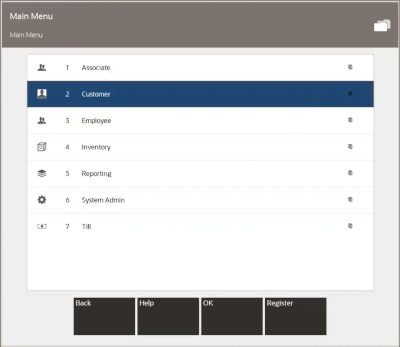
Note:
You can also press the number or letter associated with the menu option on the keyboard to access the function.
-
After logging in to the Back Office, select the Customer option from the Back Office Main Menu.
Figure 21-2 Customer Menu
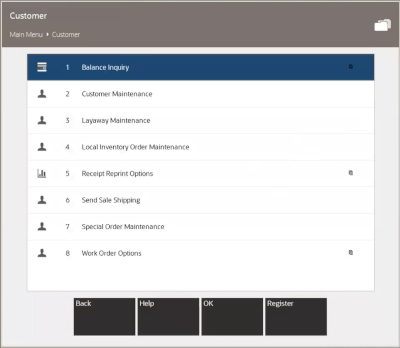
-
Select Local Inventory Order Maintenance from the Customer menu.
-
Xstore Classic displays the Local Inventory Order Search form, prompting for search criteria. Enter the criteria you want to use for finding an order record and select Process.
Figure 21-3 Local Inventory Order Search Form
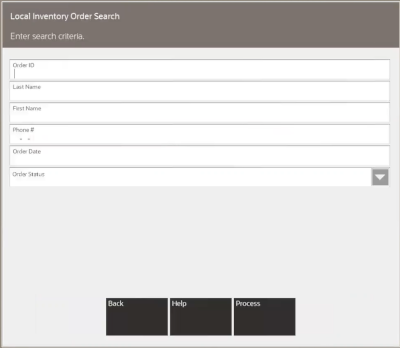
-
If you enter a Local Inventory Order ID, the system displays that Local Inventory Order record if the ID exists and if it is unique.
-
Your search criteria may result in multiple records being found. Your system may also be set up to display the accounts list even when only one record is found. You must select the record you want from the list.
Select a record from the list and Xstore Classic displays the Local Inventory Order screen for the selected record.
-
Local Inventory Order Screen
Figure 21-4 Local Inventory Order - Completed Order
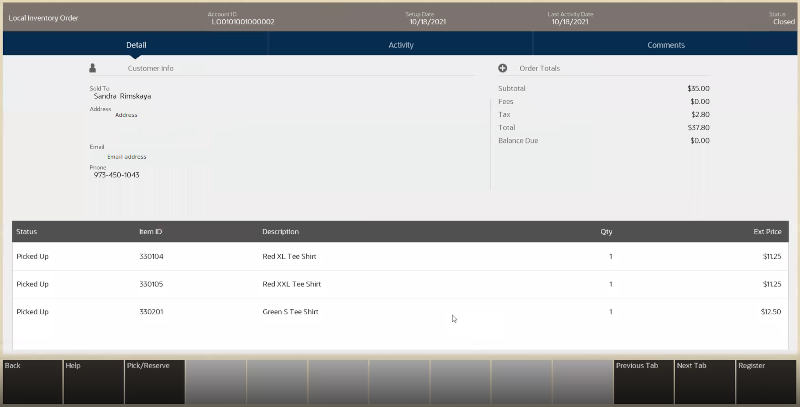
The Local Inventory Order Maintenance screen is divided into three tabs: Detail, Activity, and Comments. You can navigate between the tab sections by selecting the Detail tab or swiping right to left.
At the top of each tab, is the Static Information Area.
Each tab contains specific information about the customer's order account.
-
Detail Tab: Shows the customer and item information for the Local Inventory account.
-
Activity Tab: Shows the activity information for the Local Inventory account.
-
Comments Tab: Shows any comments associated with the Local Inventory account.
Static Information Area
The upper portion of the screen shows the summary information for the Local Inventory Order, including its status and customer contact information. This panel is always displayed when viewing any of the tabs on this screen.
Detail Tab
The Details tab, as shown above, contains the following information:
Customer Information
The customer information area displays:
-
Sold To: The purchasing customer's name and address information.
-
Company: The purchasing customer's company, if applicable.
-
Email: The purchasing customer's email address.
-
Phone: The purchasing customer's telephone number(s).
Activity Tab
Figure 21-5 Local Inventory Order Activity Tab
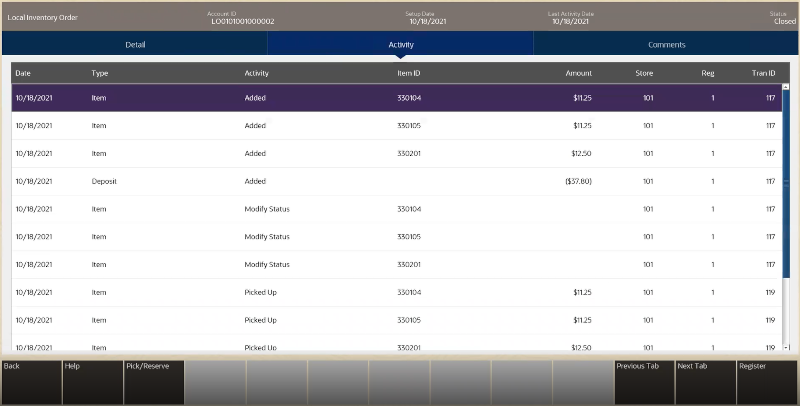
The Activity tab shows the activity information for the account such as items added, and payment made and contains the following information:
-
Date: The date the Local Inventory Order activity took place.
-
Type: The order activity type associated with the amount of the activity.
-
Activity: The action performed.
-
Item ID: The item identifier.
-
Amount: The amount for the associated type of activity on the account.
-
Store: The store identifier where the order activity took place.
-
Reg: The register identifier where the order activity took place.
-
Tran ID: The transaction identifier for the order activity.
Comments Tab
Figure 21-6 Local Inventory Order Comments Tab

The Comments tab allows you to review any comments associated with the account and contains the following information:
-
Created Date: The date this comment was added to this Local Inventory Order account record.
-
Created By: The identifier for the employee who created the comment.
-
Comment: The text that was entered.
Note:
You can also add a new comment for this order account record when viewing this tab. Select the Add Comment option.
Type a comment.

Press OK. Xstore Classic adds the new comment to the order account record.
Pick/Reserve Local Inventory Order Items
-
Find the Local Inventory Order. See Accessing Local Inventory Order Maintenance.
-
If prompted, enter search criteria to find the Local Inventory Order.
-
If a customer has been associated with the transaction, Xstore Classic returns a list of Local Inventory Orders for the customer.
-
-
Select a Local Inventory Order from the list. Only paid for open orders can be selected for picking.
-
At the Local Inventory Order screen, select Pick /Reserve to fulfil the order.
-
If prompted, select Yes to pick up all the items.
Note:
This prompt only displays when there are multiple Local Inventory Order items.
-
If Xstore Classic is configured to scan items at this Pick/Reserve process, you will need to scan the items to ensure they match the order. As items are scanned/entered they will be removed from the pick list and the item/order is marked as Ready for Pickup.
If Xstore Classic is not configured to scan items at the Pick/Reserve process, a pick slip with the items on it will print from the receipt printer. The items/order is marked as Ready for Pickup.
-
Select OK.